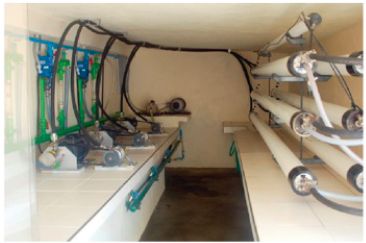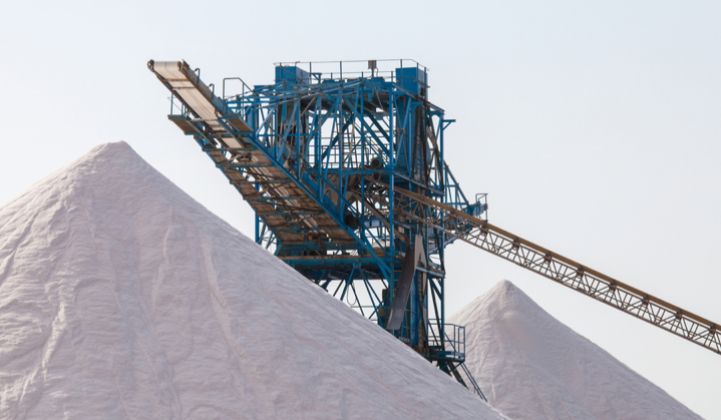The process of desalination isn’t nearly as energy-intensive as it was just a decade ago, thanks to new reverse-osmosis plant designs and nano-structured membranes that have drastically improved the energy efficiency of turning salt water into fresh water. Pairing solar, wind and other renewable energy with desalination is a potential next step, with applications from the industrial scale to the village-microgrid level.
But there is a catch.
The most efficient desalination technologies produce poor quality water when they vary the pressures or throughputs, which means they need a steady and predictable supply of electricity. Solar panels can’t provide that, absent diesel generators or batteries, which add cost and complexity.
A desalination system that can follow the ups and downs of local green power could allow more projects to flourish without those constraints -- and taken to bigger scales, it could turn constant-energy desalination plants into "demand response desalination" systems. Down in La Paz, Mexico, semi-retired inventor Jan Kunczynski has quietly been testing a potential solution to this challenge over the past decade -- and now he’s formed a company, Sisyan LLC, to bring the concept to a broader audience.
“Between 2000 and 2004, Sisyan LLC developed what we believe to be the first continuous-production, photovoltaic, seawater reverse-osmosis (PVSWRO) system,” according to the company’s new white paper on its technology. In simple terms, Kunczynski has broken the problem down through a “multi-module design concept” -- that is, lots of smaller reverse-osmosis systems, each of which can be turned on or off to match the local electricity supply, whether it’s coming from intermittent solar or reliable grid power.
It’s a similar concept to using lots of smart thermostats, water heaters, commercial refrigerators and other on-or-off electricity loads to follow the ups and downs of intermittent supply of wind and solar power in stepwise fashion. In this case, Sisyan has put three 3-horsepower modules together, each using a variable frequency drive that can maintain consistent pressure on each unit within a certain operating range at about 22 kilowatts. If total power supply falls below that minimum range, Sisyan turns off one of the units and directs the remaining power to the still-operating units, keeping them running at optimal capacity.

Ben Burger, a former disaster relief worker in Central and South America who joined Sisyan as director of partnerships and technology development, told me in an interview last week that the La Paz system has been running for more than twelve years, first in a configuration that used a battery to smooth power flow, and more recently in a solar-only setting.
“What I think we’re going to do is start going to market with small plants in the Caribbean, in Puerto Rico,” he said. “We’re looking at resorts and small communities where we know we’re competitive.” The United Nations has made energy a focus of its World Water Day efforts, in hopes of finding new ways to bring both of these life-sustaining resources to the approximately 1 billion people who live without reliable access to either.
But beyond that, the same modular concepts could be applied to the larger-scale desalination plants that are now being built in Israel and the Middle East, where they’re a critical source of fresh water, he said. It could also be applied in drought-stricken California, which “could be the next Israel” in terms of its need for desalination, he said.
California, of course, is also the epicenter of distributed solar power, as well as host to a range of initiatives meant to incorporate this intermittent resource into the grid. That includes demand response -- the ability to ramp power consumption up and down at a site to help the grid manage peak loads or variations in supply -- as well as new flexible, fast-ramping resources to help the state manage the "duck curve" distortions of its daily grid demand-supply balance.
Sisyan’s white paper lays out the concept of a “demand response desalination system,” which could consist of anywhere between five and 500 of its 22-kilowatt modules tied together. That’s more than fine-grained enough to manage most demand response programs today, and good enough to meet many of the flexibility requirements of matching the ups and downs of local solar power production.

To be sure, there are limits on the cost-effectiveness of this approach -- it’s more capital-intensive and less efficient than a “massive central desalination plant that’s collocated with a big thermal plant,” Burger noted. But “the energy recovery mechanisms we’re using are on par with any other small or medium-sized system there is -- we’re not losing any efficiency there.”
Add the potential for earning money by providing demand response, flexible capacity, supply-following and other such tricks available to the energy-variable desalination plant, and you may have a business case. With water and energy so closely linked -- about 15 percent of the world’s water supply is used to cool or operate power plants, and about 15 percent of the world’s electricity is used to move water -- we’re sure to see similar concepts advancing efficiency as applied to both electricity and water.



